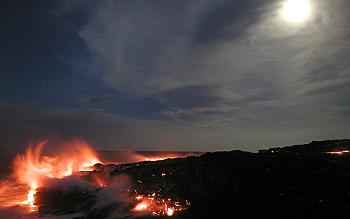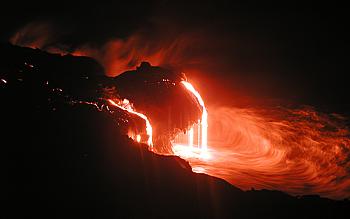Geotimes

Web Extra
Friday, August 2
Kilauea's race to the sea
 The Hawaiian volcano
Kilauea is once again dipping her pahoehoe toes into the ocean. Well, actually,
she's behaved far less delicately. After burning a path through the forest and
pacing her way over a long stretch in the last two weeks she plunged her fingers
and arms full on into the crashing waves, much to the delight of thousands of
onlookers.
The Hawaiian volcano
Kilauea is once again dipping her pahoehoe toes into the ocean. Well, actually,
she's behaved far less delicately. After burning a path through the forest and
pacing her way over a long stretch in the last two weeks she plunged her fingers
and arms full on into the crashing waves, much to the delight of thousands of
onlookers.
What began as a new vent site on May 12 sent a Mother's Day flow that ignited
a 3,600-acre fire as the lava made its way through the forest to the coastal
flat below the faultscarp Paliuli.
A Buck Moon, one day after full,
eyes the east end of Wilipe`a bench at 5:12 am on July 25.
Photos courtesy of USGS
HVO.
"As long as the new vent area kept discharging lava and the upper lava-tube
system did not break down repeatedly, it was inevitable that the flow would
eventually reach the sea," says Steven Brantley of the U.S. Geological
Survey (USGS) Hawaiian Volcano Observatory.
Sure enough, over the next five-and-a-half-weeks the flow "slowly worked
its way across the coastal flat, feinting this way and that, first to the west,
then to the east, then in the middle," according to USGS reports. As arms
of the flow reached within 400 and 700 meters of the water, a race began on
July 16 between two fingers on the closer eastern lobe. The western finger shot
forward in the lead, but the eastern finger quickly followed, closing the gap
two days later. On the night of July 18, the lava of the eastern arm, burning
famously bright red, poured into the sea at a point now called West Highcastle.
 Lava
free-falling 4 to 5 meters into the water off the eastern front of West Highcastle
bench on July 26. The underside of the breaking wave is lit by the glow from
the falls.
Lava
free-falling 4 to 5 meters into the water off the eastern front of West Highcastle
bench on July 26. The underside of the breaking wave is lit by the glow from
the falls.
The next day, the trailing western arm traveled 400 meters in a period of 20
hours gaining momentum for the final 300-meter stretch. A park building stood
in the path, but park officials had time to move it before it was destroyed.
Crossing the Chain of Craters Road, the western arm dripped and cascaded into
the Pacific down the sea cliff of Wilipe`a at dawn on July 21. In the process,
the lava drip-castle built a 470-meter wide bench that reaches 90 meters offshore.
"One only has to mingle a few minutes with visitors at the entry area
and around the budding pahoehoe toes to appreciate how truly awesome most consider
the experience of seeing molten rock spread across the ground and spill into
the sea," Brantley says. "The number of people going to the entry
area every day, sometimes more than 3,000 per day, also makes it clear that
the response is nothing short of fantastic."
Christina Reed
Links:
USGS Hawaii Volcano Observatory
Kilauea Eruption
Update
Volcano Watch
Kilauea history
 The Hawaiian volcano
Kilauea is once again dipping her pahoehoe toes into the ocean. Well, actually,
she's behaved far less delicately. After burning a path through the forest and
pacing her way over a long stretch in the last two weeks she plunged her fingers
and arms full on into the crashing waves, much to the delight of thousands of
onlookers.
The Hawaiian volcano
Kilauea is once again dipping her pahoehoe toes into the ocean. Well, actually,
she's behaved far less delicately. After burning a path through the forest and
pacing her way over a long stretch in the last two weeks she plunged her fingers
and arms full on into the crashing waves, much to the delight of thousands of
onlookers. 
 Lava
free-falling 4 to 5 meters into the water off the eastern front of West Highcastle
bench on July 26. The underside of the breaking wave is lit by the glow from
the falls.
Lava
free-falling 4 to 5 meters into the water off the eastern front of West Highcastle
bench on July 26. The underside of the breaking wave is lit by the glow from
the falls. 